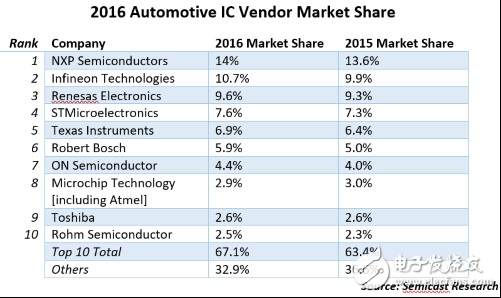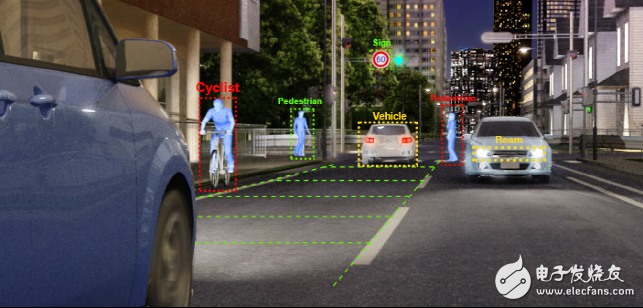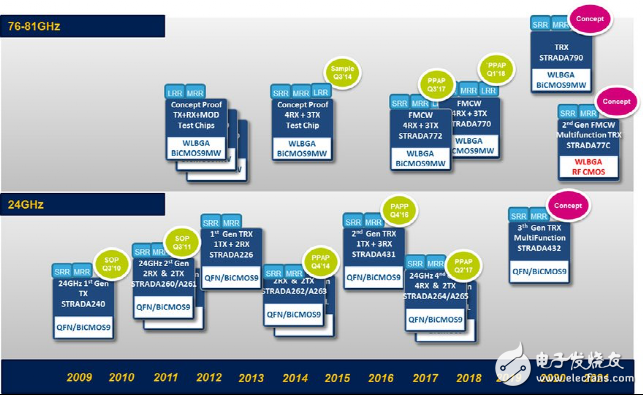In 2017, autonomous driving made many interesting changes at the chip level. In March, Intel announced the acquisition of Mobileye for $15.3 billion. Before the acquisition of Mobileye, Intel has entered the automotive market. Intel's Altera FPGA was adopted by Audi. The acquisition of Mobileye highlights its desire to gain first-mover advantage in the field of autonomous driving. intention of. Mobileye's EyeQ series processor has been manufactured by STMicroelectronics (STM, 2018 Munich Shanghai Electronics Show, E4 Hall 4104). After being acquired by Intel, it is rumored that the EyeQ series may choose Intel technology in the future, but at present, at least EyeQ 4 And EyeQ 5, which will be sampled in 2018, will also maintain cooperation with STMicroelectronics.
Tesla introduced the Nvidia chip platform in autopilot 2.0, and Musk has claimed that autopilot 2.0 has achieved five levels of autopilot in hardware. However, according to the exposure of foreign media, compared with the first generation, the number and indicators of autopilot 2.0 sensors have increased a lot, and the computing power of Nvidia Drive PX 2 is about 40 times that of Mobileye EyeQ 3, but the actual results are commented. Perhaps for a long time, perhaps because Nvidia's performance on autopilot is generally accelerated, the progress of self-developed chips, Tesla officially announced in December that it is already developing artificial intelligence chips, which is not good news for Nvidia. Of course, Nvidia, which is preparing to be a universal autopilot platform, will not rely solely on Tesla. The new Audi A8 will use Nvidia's GPU. Bosch (BOSCH, 2018 Munich Shanghai Electronics Show, E4 Hall 4400) will also be announced in March 2017. Introducing the Nvidia Drive PX platform into the new autonomous driving system. Another FPGA vendor, Xilinx (Xilinx), also partnered with Siemens business unit Mentor to launch the DRS360 autopilot platform.
Qualcomm (QUALCOMM, 2018 Automotive Technology Day sponsor) is also preparing to be a part of the automotive electronics industry. The entry point was originally the Internet of Vehicles and infotainment system, but now the mobile access rate is not high, so Qualcomm is making slow progress in the automotive field. The stagnation of the mobile phone chip market has enabled Qualcomm to accelerate the search for new growth points and finally chose direct acquisitions. In 2016, Qualcomm announced that it will acquire NXP, the largest auto semiconductor manufacturer, for US$38 billion. However, due to the wide range of cases involved in the case, the anti-monopoly agencies in various countries have been cautious in reviewing and the transaction has not been completed. According to foreign media reports, European and Japanese antitrust agencies have generally recognized Qualcomm's revised acquisition plan, and it is expected to complete the acquisition in early 2018.
Although in their respective fields, Intel, Qualcomm (excluding NXP), Nvidia and Xilinx are new recruits in automotive electronics, Nvidia, the most popular, and its automotive electronics business in September 2017. The ratio is only 6%. The world's top five automotive semiconductor manufacturers, automotive business revenue accounted for at least 15%.

Top Ten Automotive IC Manufacturers in 2016
From the table below, the fifth Texas Instruments automotive electronics business accounted for 15% of total revenue, STMicroelectronics and NXP accounted for 29%, and Infineon and Renesas even 41%. '

The top five automotive semiconductor manufacturers' automotive business revenue share
Newcomers such as Nvidia are focusing on computing platforms to find breakthroughs. The old car semiconductor manufacturers are more comprehensive in layout, from sensors, processors, in-vehicle communications, and autonomous driving chips to the power, signal conditioning, security and actuators necessary to build an automated driving system. The first few automotive semiconductor manufacturers have a relatively complete product line.
Unlike the new manufacturers' big propaganda wars, traditional manufacturers pushed forward the autonomous driving strategy in 2017 with a low profile. In July 2017, Toshiba (TOSHIBA, 2018 Munich Shanghai Electronics Show, E4 Hall 4200) announced the launch of a video-based active security system with Japan Denso. The system is equipped with Toshiba's latest VisconTI 4 autopilot chip. The VisconTI 4 has 8 multimedia processing cores that can execute 8 applications simultaneously. It is optimized for autopilot video applications, and the recognition speed is reduced from 100 milliseconds to 50 milliseconds. Only the VisconTI 4 can be used to construct lane departure warnings, front and rear collision warnings, front and rear pedestrian collision warnings, traffic signs and signal recognition. Denso has been using Visconti 2 for assisted driving since 2015. In addition to double the number of cores, Visconti 4 has improved many pedestrian recognition algorithms than the previous generation. Visconti4 with enhanced CoHOG recognition algorithm has greatly improved The ability to recognize pedestrians and cyclists in dark scenes.

Visconti 4 detects pedestrians and bicycles
On the car camera side, Sony (SONY, 2018 Automotive Technology Day sponsor) released a 7.42 effective megapixel car-mounted CMOS image sensor in October. The horizontal resolution of the image sensor is nearly 2 times higher than that of the previous generation. The traffic sign was taken 160 meters away. In order to improve the sensitivity in the dark environment, the high-sensitivity pixel addition mode is adopted to achieve a high sensitivity of 2666 mv, and pedestrians or obstacles can be clearly captured even on a moonlight night. According to Sony, the camera can be adapted to Mobileye's EyeQ 4 and EyeQ 5, which will be mass-produced in June 2018.
Millimeter wave radars are playing an increasingly important role in autonomous driving. According to Infineon, at least six millimeter-wave radars, four cameras and one lidar module are required to achieve three-level automatic driving, while at least 10 millimeter-wave radars are required for four- or five-level automatic driving. 8 cameras and 1 lidar module, so the integration of sensors and their data is critical to the development of autonomous driving.

Autopilot dramatically increases the number of sensor requirements
Bosch (BOSCH, 2018 Munich Shanghai Electronics Show, E4 Hall 4400) has consistently ranked first in radar module shipments. Long-range radar (77GHz band) is the core product, and its fourth-generation long-range radar LLR4 has a high detection range. 250 meters, can detect up to 24 targets. The millimeter wave radar chip is the world of Infineon, STMicroelectronics and NXP. ST's A770 is a single-chip solution that integrates three transmitters, four receivers, a configurable sawtooth generator, an ADC, and an MIPI CSI II interface.
STMicroelectronics (STM, 2018 Munich Shanghai Electronics Show, E4 Hall 4104) also introduced the industry's first in-vehicle microprocessor Telemaco3P with integrated dedicated fully isolated hardware security module (HSM) in 2017. One of the major obstacles to the development of car networking is information security. For a behemoth that moves at such a high speed, if it is hacked or interferes with communication, the consequences can be catastrophic. So whether it's mobile audio and video entertainment, geographic information-based rescue services, or the recent hot software over-the-air (OTA), the foundation of these functions is the ability of cars to deliver information in a timely and effective manner. The HSM checks and secures the received external information. The information that is not securely authenticated and the external device cannot communicate with the protected module. The information sent by the Telemaco3P is also encrypted by the HSM, and the dedicated hardware module is used for security management. It will greatly enhance the safety of in-vehicle communication.

STMicroelectronics Millimeter Wave Radar Roadmap
The introduction of a number of sensors by autopilot technology, coupled with the Internet of Vehicles, has led to a surge in in-vehicle storage demand. According to Intel estimates, in the future, a fully-automated driving vehicle will generate 4000 GB of data per day, achieving a fifth-level automatic driving (ie, full Automatic) places high demands on memory bandwidth and capacity. Micron (2018 Automotive Technology Day sponsor) is developing GDDR6 to meet the requirements of autopilot technology for car memory capacity and bandwidth. Micron is also developing PCIe interface non-volatile memory to meet 5G communication and HD maps. The need for non-volatile storage with the car black box.
As can be seen from the above, the new generation of automotive semiconductor manufacturers put more emphasis on the new concept, because the market share is relatively small, so we must focus on "subversion", in the hope of changing the traditional pattern, the traditional manufacturers are more focused on practical, on the existing basis Extend before to maintain the original advantage. In 2018 and 2019, more and more new changes will occur in automotive electronics. The commercialization of 5G commercialization will further promote the development of vehicle networking. The introduction of the fuel vehicle ban will also accelerate the transformation of the industrial chain into new energy sources. Many start-up companies that have been in the field for several years may be ushered in a big test and will gradually differentiate in the future. How the market evolves depends on time.
Led Coaster, Led Light Up Music Coaster, Flashing Led Coaster
AST Industry Co.,LTD , https://www.astsoundchip.com
